Recent Posts
Planning and Preparing for Fire Disasters | SERVPRO of Cedar City/Fillmore
5/6/2024 (Permalink)
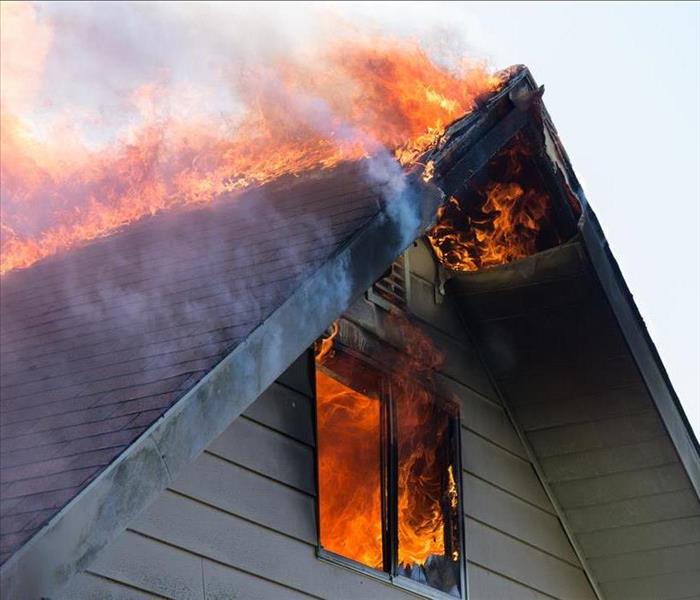 Ensure the safety of your household and loved ones. Reach out to SERVPRO of Cedar City/Fillmore today.
Ensure the safety of your household and loved ones. Reach out to SERVPRO of Cedar City/Fillmore today.
House fires can happen at any time and to anyone, and they can cause serious destruction to your beloved family home. That’s why it’s important to prepare your family for a potential house fire disaster before a true emergency occurs.
By taking the necessary precautions and practicing fire safety, you can help keep your family safe. Our SERVPRO® team offers some tips to help you prepare for a house fire below.
Create an Emergency Plan
Creating an emergency plan is the first step in preparing for a house fire. Make sure that everyone in your household is familiar with the emergency plan and knows what to do in case of a fire. The emergency plan should include a designated meeting place outside of the home, emergency phone numbers and escape routes from each room in the house.
It’s important to practice the emergency plan with your family so that everyone knows what to do in case of a fire. Have your family pick different places around your home to be in and then simulate a fire emergency. Time everyone to see how long it takes for your family to get to safety!
Install Smoke Detectors
Install smoke detectors throughout your home, especially in bedrooms and near the kitchen. Smoke detectors can alert you to a fire and give you time to evacuate your home, but only if they are working properly.
Make sure to test your smoke detectors regularly to ensure that they are functioning—and replace them completely every 10 years. If a smoke detector is not working, replace the battery immediately.
Practice Fire Safety
There are many things you can do to practice fire safety in your home. One of the most important things is to be mindful of open flames. Keep flammable items away from open flames, such as candles, stovetops and fireplaces.
Do not leave cooking food unattended on the stove and make sure to turn off all appliances and electronics before leaving the house. In addition, it’s important to be mindful of the electrical wiring in your home.
Do not overload outlets with too many appliances or electronics and replace frayed cords and wires immediately. In case of a fire, it’s important to have a fire extinguisher readily available.
Call for Help
If a fire does occur in your home, get out of your home immediately and call 911 from your family’s pre-determined safe location. Once the fire department arrives and puts out the fire, get us on the phone right away.
Our fire damage restoration team is here to help you recover faster. We will clean, sanitize and rebuild your property from the ground up. We will take care of you no matter how extensive your damage is.
Protect your home and your family. Contact SERVPRO of Cedar City/Fillmore today.
The Silent Menace: How Smoke Damage Can Devastate Your Home and Why Professional Restoration is Crucial
7/27/2023 (Permalink)
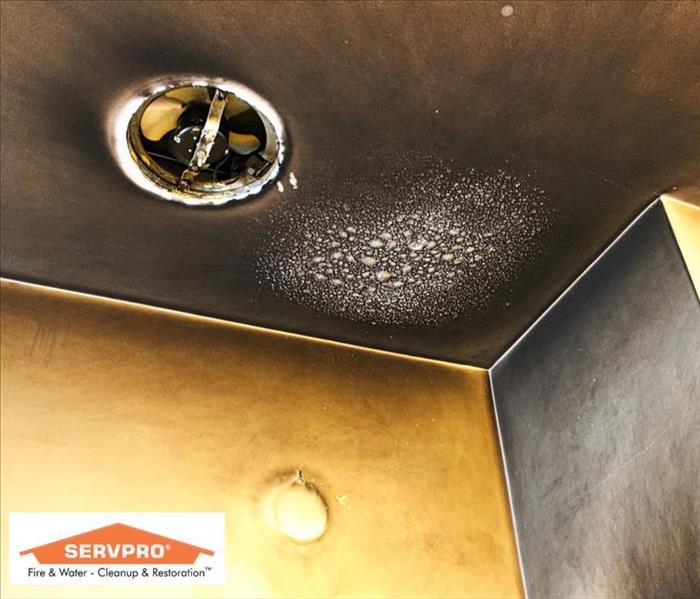 Smoke Damage
Smoke Damage
When we think of a fire's destructive force, we often envision flames engulfing everything in their path. However, there is a silent but equally menacing aspect of a fire's aftermath that often goes overlooked: smoke damage. Smoke can wreak havoc on a home and its contents, causing extensive and lasting harm. In this blog, we will delve into the perils of smoke damage and shed light on why enlisting SERVPRO Of Cedar City/Fillmore is the wisest choice when facing such a situation.
The Devastating Impact of Smoke Damage
Smoke damage is an insidious force that permeates every nook and cranny of a home. As a fire burns, it releases particles and harmful gases into the air. These tiny particles and toxic fumes can penetrate various surfaces, leaving a lingering stench and discoloration. Commonly affected areas include walls, ceilings, floors, furniture, electronics, and even HVAC systems. The longer the smoke residue remains untreated, the more it ingrains itself, making it increasingly difficult to remove without professional intervention.
1. Health Hazards
One of the most alarming consequences of smoke damage is the detrimental impact it can have on the health of occupants. Smoke particles can trigger respiratory issues, eye irritation, and worsen pre-existing conditions like asthma or allergies. Additionally, the harmful gases released during combustion can be life-threatening if inhaled for prolonged periods.
2. Structural Deterioration
Smoke residues contain corrosive substances that can damage building materials over time. Wooden structures may weaken, and metals can corrode, compromising the overall integrity of the property. Addressing smoke damage promptly can prevent further deterioration and save homeowners from costly repairs down the line.
3. Lingering Odors
Smoke odors are notorious for their tenacity. They can linger for months or even years if not treated properly. Attempting to mask the smell with air fresheners or DIY solutions only provides temporary relief and does not address the root cause. Professional restoration companies employ advanced techniques to neutralize odors at their source.
How a professional company like SERVPRO Of Cedar City/Fillmore is your best choice
In the face of such formidable challenges, entrusting the process to SERVPRO Of Cedar City is the most prudent decision homeowners can make. Here's how these experts can help:
1. Comprehensive Assessment
A reputable restoration company will begin by conducting a thorough assessment of the property and its contents. They'll identify the extent of the smoke damage and create a detailed plan to address each area effectively.
2. Specialized Equipment and Techniques
Professional restoration companies utilize specialized equipment and techniques that are beyond the reach of DIY methods. High-powered vacuums, ozone machines, air scrubbers, and thermal foggers are just a few examples of the advanced tools used to eliminate smoke particles and odors.
3. Safe and Efficient Cleaning
Smoke damage requires meticulous cleaning to prevent further harm. Trained technicians know which cleaning agents and methods are suitable for different surfaces and materials. They can salvage and restore items that might seem beyond repair to untrained eyes.
4. Preventive Measures
A reliable restoration company doesn't just treat the visible damage; they also implement preventive measures to mitigate future risks. This might include sealing surfaces to prevent smoke particles from resurfacing, or providing advice on fire-resistant materials for reconstruction.
Smoke damage can be just as devastating as the fire itself, leaving a trail of destruction that extends far beyond the immediate aftermath of a blaze. The health hazards, structural deterioration, and persistent odors associated with smoke damage underscore the need for professional intervention. By enlisting the services of SERVPRO Of Cedar City, homeowners can rest assured that their property and belongings will be restored to their original condition. The expertise, specialized equipment, and preventive measures offered by SERVPRO Of Cedar City make them the best choice in facing the daunting task of smoke damage restoration.
Unveiling the Silent Threat: Recognizing Signs of Mold in Your Home
7/26/2023 (Permalink)
 mold in home
mold in home
Imagine coming home after a long day, and instead of being greeted by a warm, welcoming ambiance, you are met with a peculiar, musty odor. Your eyes may start to itch, or you might even experience respiratory issues. If you encounter any of these symptoms, it's time to delve deeper into a potential problem that could be lurking in your home: mold.
Mold is a common household problem that can pose serious health risks if left unchecked. It's not always visible, and its stealthy nature can lead to extensive damage to your property and even your well-being. To keep your home and loved ones safe, it's crucial to be aware of the signs of mold and know when to call in the professionals.
1. Musty Odor
One of the first indications of mold growth is a persistent musty smell in certain areas of your home. This odor often resembles damp or rotting wood and is particularly noticeable in basements, bathrooms, or other areas with poor ventilation. Don't ignore this unpleasant scent, as it could be an early warning sign that mold is present and actively spreading.
2. Visible Mold Spots
While some mold infestations may be concealed, others are quite apparent. Keep an eye out for visible mold growth on walls, ceilings, or floors. Mold can appear in various colors, including black, green, white, or even orange. It may present as fuzzy patches, small specks, or even slimy textures. Never disregard these visible signs, as they indicate a potentially more extensive problem underneath the surface.
3. Water Leaks and Damage
Mold thrives in moist environments, making water leaks a primary catalyst for its growth. Pay close attention to any signs of water damage, such as water stains on ceilings or walls, peeling paint, or warped surfaces. These areas are breeding grounds for mold, and prompt action is crucial to prevent further contamination.
4. Allergic Reactions
Mold can have adverse effects on human health, especially for those with allergies or respiratory conditions. If you or your family members experience unexplained allergic reactions such as sneezing, coughing, nasal congestion, skin rashes, or watery eyes, mold could be the culprit. Such symptoms may worsen when spending time in specific areas of your home, indicating mold presence.
5. Increased Humidity
Excess humidity in your home can create an ideal environment for mold to flourish. If your indoor spaces feel consistently damp or you notice condensation on windows and walls, it's essential to address the humidity issue promptly. Mold loves moisture, and controlling the humidity levels can help prevent its growth.
6. Health of Your Home
Mold doesn't just affect your health; it can also harm the structure of your home. Rotting wood, crumbling drywall, and weakening foundations are all potential consequences of long-term mold infestations. By paying attention to the well-being of your home, you can identify problems early on and take appropriate action.
Why You Should Call Professionals:
When dealing with mold, it's crucial to prioritize your safety and the well-being of your family. While minor mold issues can sometimes be remedied with DIY methods, larger infestations or hidden mold may require professional intervention. Here's why you should call professionals to remove mold:
1. Proper Identification and Elimination
Certified mold remediation professionals have the expertise and tools to accurately identify the type and extent of mold infestation. They can develop a comprehensive plan to eliminate the mold safely and effectively, preventing further spread.
2. Safety Measures
Mold removal involves handling potentially hazardous materials and using specialized equipment. Professionals follow strict safety protocols to protect themselves and your household during the remediation process.
3. Addressing the Root Cause
Professionals not only remove the visible mold but also address the underlying issues that caused the infestation in the first place. Whether it's repairing leaks or improving ventilation, they help ensure that mold won't return in the future.
4. Preventing Cross-Contamination
Improper handling of mold can lead to cross-contamination, spreading mold spores to unaffected areas of your home. Professionals employ containment strategies to prevent this from happening, safeguarding your living spaces.
In conclusion, mold can silently invade your home, posing health risks and causing structural damage. To protect yourself and your loved ones, keep an eye out for signs of mold and take action promptly. When faced with a substantial mold problem, always seek the help of certified professionals to ensure a safe and thorough mold remediation process. A mold-free home is not just a healthy home but a happy one too.
Preparing Your Home for Fall Storms in Utah's Mountains
7/24/2023 (Permalink)
 Utah Mountains
Utah Mountains
As the vibrant colors of summer give way to the golden hues of fall, residents of Utah's mountainous regions are well aware of the impending seasonal shift. With the changing leaves and crisp air, however, also comes the possibility of fall storms, which can bring heavy rain, strong winds, and even snow to the higher elevations. Homeowners in these areas must be proactive in preparing their properties to weather the elements and safeguard their loved ones and belongings. In this blog, we will explore some essential steps that homeowners can take to brace themselves for the fall storms and ensure their homes remain safe and secure during this time.
1. Inspect the Roof and Gutters
One of the first areas to check in preparation for fall storms is the roof. Inspect for any damaged or missing shingles, as these can lead to leaks during heavy rain or snowfall. Address any issues promptly to avoid potential water damage. Additionally, ensure that the gutters and downspouts are clear of debris to allow rainwater to flow freely away from the house. Clogged gutters can cause water to overflow and pool near the foundation, potentially leading to water infiltration.
2. Trim Trees and Shrubs
Tall trees and overgrown shrubs can become a hazard during strong winds. Before the fall storms arrive, trim any branches that are close to the house or powerlines. This will reduce the risk of branches breaking off and causing damage. Additionally, clearing out dead vegetation around the property can help minimize fire hazards during dry spells that may accompany fall weather.
3. Reinforce Windows and Doors
Sealing gaps around windows and doors is an essential step in preparing for fall storms. Use weatherstripping and caulking to keep cold drafts out and maintain the warmth inside your home. Consider installing storm shutters or boarding up windows if you anticipate severe weather conditions. Secure any loose outdoor furniture or equipment that could become airborne during high winds.
4. Check Heating Systems
As fall temperatures drop, ensuring your heating systems are in good working condition is vital. Have your furnace or heating system inspected and serviced by a professional to guarantee it will keep your home cozy during cooler days and nights. Clean or replace filters regularly to improve efficiency and indoor air quality.
5. Stock Up on Emergency Supplies
Be prepared for potential power outages or being snowed in by stocking up on emergency supplies. Create an emergency kit with essentials like flashlights, batteries, bottled water, non-perishable food items, first aid supplies, and blankets. It's also wise to have a battery-powered radio to stay informed about weather updates and any emergency alerts.
6. Reinforce the Garage and Shed
If you have a garage or shed, ensure that the doors are properly secured and able to withstand strong winds. Reinforce the structure if necessary, and consider moving valuable or fragile items to a safer location within your home. Secure any outdoor tools or equipment to prevent them from becoming projectiles during a storm.
Conclusion
Utah's mountainous regions offer breathtaking scenery year-round, but the beauty of fall can be accompanied by unpredictable storms. By taking the time to prepare your home for the changing weather, you can protect your property and loved ones from potential harm. Inspect the roof and gutters, trim trees and shrubs, reinforce windows and doors, check heating systems, and stock up on emergency supplies. With these precautions in place, you can face fall storms with confidence, knowing that you've done your best to safeguard your home and family during this beautiful yet challenging season.
Preserving Your Cabin: The Importance of Turning Off Water When You're Away
7/24/2023 (Permalink)
 cabin in woods
cabin in woods
Owning a cabin tucked away in a serene, natural setting is a dream come true for many. However, with the beauty of cabin life comes a responsibility to protect your property, especially when it's left unattended for extended periods. One of the most crucial tasks cabin owners must undertake before leaving is turning off the water supply. In this blog, we will explore the significance of this preventive measure and how it can prevent potential disasters such as burst pipes and water damage, ultimately ensuring that your cabin remains a tranquil oasis for years to come.
1. Avoid Burst Pipes and Costly Repairs
One of the main reasons to turn off the water to your cabin is to avoid the nightmare of burst pipes. When a cabin sits unused for an extended period, the water inside the pipes can freeze during colder months, causing them to expand and burst. This can lead to significant water damage, not only to the pipes but also to the surrounding structures and belongings within your cabin. Repairing burst pipes can be a costly and time-consuming process, easily spoiling the joy of owning a cabin.
2. Prevent Mold and Mildew Growth
When water leaks go unnoticed, it creates an environment ripe for mold and mildew growth. Mold can spread rapidly, especially in damp and dark areas such as basements or hidden corners of your cabin. Not only does mold pose health risks to occupants, but it can also cause irreversible damage to the cabin's structure and belongings. By turning off the water, you eliminate the possibility of leaks and reduce the risk of mold infestation.
3. Conserve Water and Energy
Turning off the water supply to your cabin is not only about preventing damage; it's also an eco-conscious decision. By shutting off the water when you're away, you reduce water wastage and contribute to water conservation efforts. Moreover, you save energy by ensuring that your water heater isn't constantly working to maintain the water temperature while the cabin is unoccupied.
4. Avoid Unpleasant Surprises
Nothing ruins a relaxing getaway to your cabin like discovering water damage or a flooded interior upon arrival. Turning off the water before leaving ensures that you won't be greeted by any unpleasant surprises. Instead, you can focus on enjoying your time at the cabin without worrying about potential repairs and costly cleanup.
5. Peace of Mind
Knowing that you've taken the necessary precautions to protect your cabin from water-related disasters provides peace of mind. Whether you're away for a few weeks or several months, you can rest assured that your cabin is safe from water damage. This peace of mind also allows you to fully embrace the joy of cabin ownership, appreciating the beauty of nature and the tranquility it offers.
6. Simple Steps to Turn Off Water
Turning off the water supply to your cabin is a relatively simple process. Start by locating the main shut-off valve, which is typically located near the water meter. Turn the valve clockwise until it is fully closed. Once the water is off, open all faucets and flush toilets to drain any remaining water from the pipes. Additionally, consider draining your water heater to prevent any potential issues while you're away.
A cabin represents more than just a structure; it's a place of solace and cherished memories. To preserve this haven and protect it from water-related disasters, turning off the water before leaving is of utmost importance. By doing so, you prevent burst pipes, water damage, mold growth, and high repair costs. Additionally, you contribute to water conservation efforts and enjoy the peace of mind that comes with knowing your cabin is safe and secure while you're away. Take the simple step of turning off the water, and your cabin will continue to be a cherished retreat for generations to come.
4 Important Elements of Content Cleaning After a Fire
7/26/2022 (Permalink)
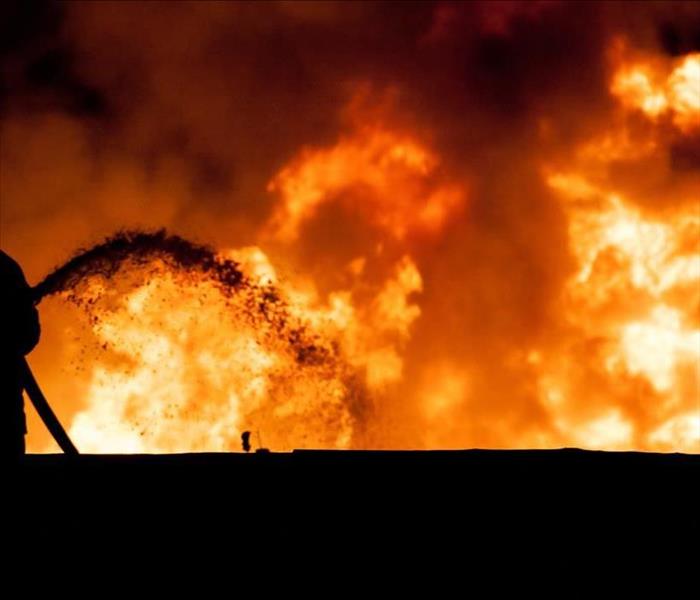 Fire damage in Cedar City, UT.
Fire damage in Cedar City, UT.
When a commercial fire strikes, your company in Cedar City, UT, will have a lot of steps to take before the recovery is complete. Not only will you need to deal with the insurance company and the restoration and cleaning of your facility, but you will also need to make sure all of the damaged contents in your building are looked at. This process involves several important elements such as deciding on replace versus restore and whether dry-cleaning will work on smoke-damaged fabrics.
4 Crucial Steps for Content Cleaning After a Business Fire
1. Restore or Replace
After a fire, it is important to make cleaning decisions based on knowledge and evidence. Not all contents can be cleaned, but some can, so how do you tell the difference? An experienced fire remediation franchise will pretest items and see if they are good candidates for cleaning. Whenever possible, restoring clothes and upholstery is more economical and it can also preserve special items that are irreplaceable. Technicians won't assume that an item can't be restored and will use rigorous testing methods to determine the viability of cleaning.
2. Content Cleaning Methods
A fire impacts all types of materials, from the glass of windows to the ceramics of bathroom tiles to the fabrics of clothes and upholstery. An experienced remediation team will match the material to the optimal cleaning method. They will use dry-cleaning for clothes and furniture, and ultrasonic options for certain nonporous items. Other effective options for cleaning damaged contents include the following methods:
- Wet cleaning
- Spray and wipe
- Foam cleaning
- Abrasive cleaning
- Immersion cleaning
3. Pack Outs and Moving
In some cases, it makes more sense to remove items from the fire-damaged area. This has dual benefits, such as making the area of cleanup less cluttered and protecting fragile items. It can also make the entire process more efficient. Content storage is a technique that is used in the aftermath of a fire, especially when you have insurance coverage for this process.
When the rest of your building is cleaned and restored, the items can then be moved back into your building. This is done on a schedule that meets the needs of your company.
4. Electrical Cleaning
Many specific requirements exist for cleaning and protecting electrical components after a fire. The fine film from soot and smoke can make computers, printers, television sets and other devices susceptible to additional damage if not treated properly. Items should not be turned on until cleaned and prompt action should be taken to stop corrosion and further damage.
In most cases, only a qualified electronics person can inspect and clean sensitive equipment. Often, due to fire fighting efforts, the devices also have water damage, further complicating the cleanup. While many devices can be restored after a fire, there are times when the damage is too extensive and items will need to be replaced.
With a variety of cleaning options available to them, technicians can restore many contents to good condition. Dry-cleaning and other methods can help restore many of the items damaged in a business fire.
4 Immediate Steps To Take for Your Flooded Company
7/26/2022 (Permalink)
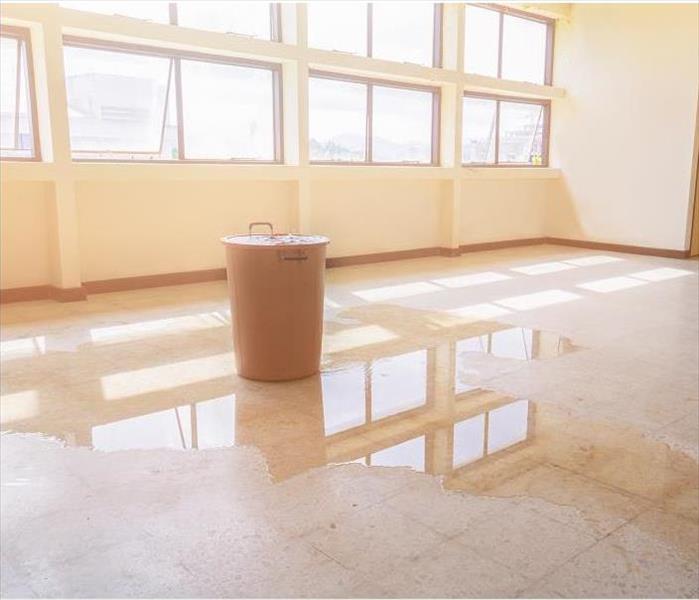 Flooding in a commercial building.
Flooding in a commercial building.
Water damage is one of the most common and most expensive causes of concern for your business in Cedar City, UT. Unfortunately, your flooded company will experience much more damage if you hesitate to have the situation corrected right away.
Address Content Cleaning in Your Flooded Company Immediately
Mold growth, mildew, unpleasant odors, and stains are some of the biggest concerns regarding your property and your belongings. In as little as 24 hours, mold spores could begin their work of breaking down the organic materials in your building and furnishings. Secondary damage, such as shorts caused by rust on electronics and wiring, continues as long as moisture is present.
1. Establish a Safe Environment
Depending on the cause of water damage, you may need to evacuate your building and make sure that employees and customers are safely away from all potential sources of risk. You also need to shut off the source of water and turn off all electricity coming into your building. Don’t wait until an emergency strikes to become familiar with the shutoff valves and switches on your property. You must be familiar with these fixtures, maintain access to them and practice using them.
There are risks to approaching cleanup in your flooded company. These include contamination from black water, exposure to structural weakness and injuries or additional damage because of hidden dangers.
2. Contact Insurance and Cleanup Providers
It takes time for your insurance company to respond to your claim. Several professionals are involved, including an adjuster and the water damage cleanup and repair technicians. The sooner you get your case moving forward, the sooner you’ll get your property back in business. Your insurance company may recommend a cleanup agency that should arrive right away to tarp and board up any damaged doors, windows and building structures.
3. Begin the Drying Process
When it is safe for you to return to your property, work with professionals to remove water and reduce humidity throughout the building. This generally involves the installation of commercial-grade fans, increasing ventilation and removing soggy contents from the building. As you carry out equipment and furniture, be aware of the potential for damaging your belongings and for physical injuries. Make sure that you have a place to store your belongings where they can continue to dry without becoming vulnerable to more damage.
4. Clean, Repair, Restore and Replace
While technicians focus on high-priority tasks inside, you can begin sorting through your belongings. Electronics, books, sensitive paperwork, computers and similar items should be sorted according to the attention they need. Some may require a simple cleaning while others will be thrown out and replaced. Cleanup pros may provide specialized cleaning, including dry cleaning and disinfection, for some of your furnishings. Some possessions may have more value than others, and these should be cared for right away. For example, valuable artwork or hardwood furniture needs to be treated by professionals and not allowed to sit.
Whether you are responding to a broken pipe or water stains after a heavy downpour, the actions you take right after a water disaster will affect the long-term outcome on your property. Keep your flooded company safe by acting immediately.
Tips for Keeping Your Sump Pump in Top Condition
7/20/2022 (Permalink)
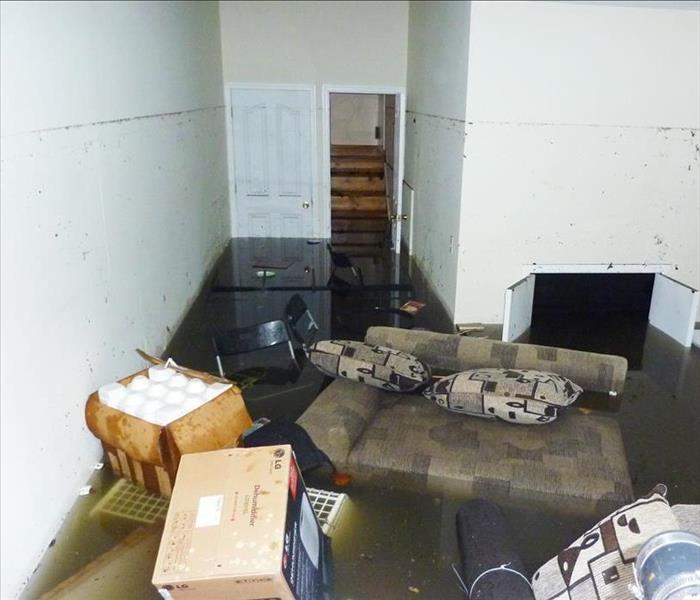 Flooding in a local home.
Flooding in a local home.
A basement is more prone to water accumulation simply from its lower location. As a homeowner in Cedar City, UT, you should focus on keeping this area dry and maintaining a functioning sump pump.
5 Tips for Caring for Your Home's Sump Pump
You may not enter your basement daily, but you do want to keep it dry and free from harm. Sump pumps allow you to go about your day while monitoring the water buildup. The pump often sits in a lower portion of the space. Water drains into it, and when water levels hit a particular point, the unit turns on, pulling fluid from the structure.
Get proactive, checking the pump. You don't want this device to fail. If it does, you could have a flood on your hand, requiring a water restoration company to clean up the mess. Use the following maintenance tips to verify your unit is in working order.
1. Clear Out Debris
Make it a priority to check your device for buildup. When the water flows into it, rocks, girt and small items get picked up. These items block the flow, preventing the sump pump from working its best. Therefore, examine the inlet screen every few months and after severe storms.
2. Complete a Test Run
Set aside a few times a year to ensure the pump works correctly. Grab a bucket of water, and pour it down the pump's opening. It should trigger a response, kicking it into action. Keep an eye on the flow. Ensure the water heads into the pipes and out of the house. Once outside, it should move away from the foundation. If you suspect a problem, call professionals in to make necessary repairs.
Don't wait to correct concerns. Any issues with this test indicate an improper operation which could lead to puddles and floods. Water damage occurs quickly and allows for mold growth to start.
3. Clear Out the Lines
Debris can move from the screen into the unit's lines. When you complete your pump maintenance check, keep an eye on how the water moves once in the device. If it's not leaving quickly or seems sluggish, turn off the pump and disconnect the pump tubes. Clear it out to improve the movement.
4. Examine the Float
The pump relies on a floating control system. When the water enters, it moves to the top, sensing the fluid levels. If it's obstructed at all, it could fail to react correctly. The device may run too long, overworking the system or fail to respond, allowing water buildup. See that it's moving upwards and has nothing blocking its path.
5. Verify Battery and Electric Work
The pump plugs into an electrical circuit. Double-check its functionality. Ensure the cord isn't worn or frayed. Furthermore, your unit should turn on with a battery backup if the electricity goes out. These die after a few years, so note when you put it in and change it every couple of years.
As a concerned homeowner in Cedar City, UT, recognize the significance of your sump pump. This device protects from flood damage, mitigating harm and restoration costs. Strive to check on it often, ensuring it's in good condition.
Fire Emergency Tips for Homeowners With Pets
6/23/2022 (Permalink)
 Follow our Fire Emergency Tips and protect your Pets, Family and Property.
Follow our Fire Emergency Tips and protect your Pets, Family and Property.
Your pets bring you incalculable joy and comfort, and their well-being is likely a high priority for your family. That's why they need to be part of any fire emergency plan you have for your home in Cedar City, UT.
Pet Safety Strategies To Use During a Fire
Any animal you have in your home depends on you for its safety and care. Pet preparation for a home fire boils down to rescue assistance, accident prevention and an emergency escape plan.
Make Pet Rescue as Easy as Possible
When you travel, you likely take your pets with you or leave them with a sitter. If they're home alone while you're out for the day, though, your pets still need a way to get out in the event of a fire. Most of the time, the task is going to fall to the firefighters who arrive on the scene.
Their main priorities, however, are going to be making sure that there are no people to rescue and putting the fire out so that it doesn't spread. There are a few precautions you can take ahead of time to make it easier to free your pets:
- Place a pet alert decal on a window near the front door of your home. This tells firefighters or anyone else who may need to enter that the animals are present.
- Keep pets near the front door when you leave your home for the day so that the emergency team doesn't have to look for them.
- Make sure your pets are wearing collars and that leashes are within grasp near the front door.
Prevent Animals From Starting Fires
The best way to handle a fire emergency is to keep it from happening altogether. Pets don't recognize fire hazards, so you need to take precautions on their behalf. Never leave a pet alone with an open flame. You may not think it's a big deal to leave the room with the fireplace still blazing or a lit candle sitting on the table, but it only takes a matter of seconds for a curious cat or dog to get too close and cause a problem.
Young pets are particularly prone to accidents. If you ever leave your young dog alone at home, for example, you need to puppy-proof any area it has access to. Remove the knobs from the stove so that the animal doesn't chew or brush against them and ignite the burners. Better yet, keep young pets crated or sequestered away from potential threats.
Include Pets in Evacuation Plans
Any fire escape plan you have for your family needs to include pet safety. Designate a specific member of the family to make sure the pets get out. Incorporate the animals in your family fire drills so that they are more likely to remain calm and listen to commands if an actual emergency occurs.
Certified restoration experts advise that you adequately prepare the whole family for a fire emergency. This includes any pets that live in your home. Understanding how to keep your beloved animals safe is a key component of pet ownership.
Why You Should Not Use Chemicals To Clean a Clogged Drain
6/17/2022 (Permalink)
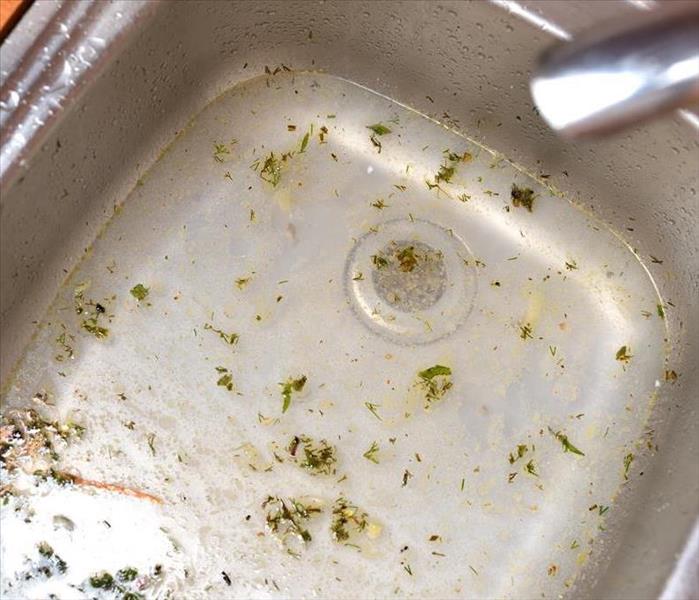 To Clean a Clogged Drain will be safer by following our tips.
To Clean a Clogged Drain will be safer by following our tips.
A clogged drain does not just slow down your plumbing system. It could cause a severe backup that floods your Cedar City, UT, home. While sewage cleaning professionals can help you in this situation, you should also take steps to prevent water damage in your house. You may be tempted to use chemicals to clear your drain. However, they often do more harm than good.
Chemical Drain Cleaner Can Damage Your Pipes
Chemical cleaners either take electrons from the organic substances clogging your drain, or they give electrons to those substances. This process creates heat that breaks up the blockage. The main types of drain cleaners include:
- Oxidizing cleaners
- Acid cleaners
- Caustic cleaners
While these cleaners sound good in theory, they often just push the oil, grease or fat in your drain further down the pipes. This creates a new clog that may be even tougher to clear.
Potential Dangers of Chemical Cleaners
Chemical cleaners are not just ineffective. They are also harmful. Once they are poured down the clogged drain, the chemicals travel through the pipes and settle in rivers and lakes. The chemicals may then poison animals and destroy plants.
These cleaners could also affect you and your loved ones. The chemicals are strong enough to burn through your skin. This could leave you with rashes or other open sores. You may develop throat or eye irritation just from breathing in the toxic fumes.
Drain Cleaning Alternatives
There are two safer options for removing drain clogs. You should first try mechanically clearing the drain with an auger or plunger. A small cup plunger is perfect for sinks. To use it, remove the stopper from the drain and cover the hole with a slightly wet rag. Then fill the sink halfway and place the rubber cup of the plunger over the whole. Apply quick pressures and see if the water starts draining.
If you do need to pour a cleaner down the drain, opt for a more natural solution. You can make an effective homemade de-clogger with just a half cup of vinegar and a half cup of baking soda. Pour the baking soda into the drain first and follow with the vinegar. Use a damp cloth to keep the drain hole closed. After a few minutes, add hot water to flush away the debris. Pour the water using a tea kettle so you do not burn yourself.
Remember that PVC pipes soften when exposed to hot temperatures. If you have these pipes in your home, do not use boiling water when clearing the drain. Instead of making your own cleaner, you could also buy a solution made of eco-friendly enzymes. Enzymes essentially eat the organic materials that often cause clogs. However, enzyme cleaners may take up to 24 hours to work.
If you notice a clogged drain in your home, you should only use chemical cleaners as a last resort. Instead, try clearing the blockage with an auger or plunger. If that does not work, try pouring a non-toxic enzyme cleaner down your drain. This should break up the clog without introducing toxic chemicals into the environment.
 Ensure the safety of your household and loved ones. Reach out to SERVPRO of Cedar City/Fillmore today.
Ensure the safety of your household and loved ones. Reach out to SERVPRO of Cedar City/Fillmore today.



 24/7 Emergency Service
24/7 Emergency Service








